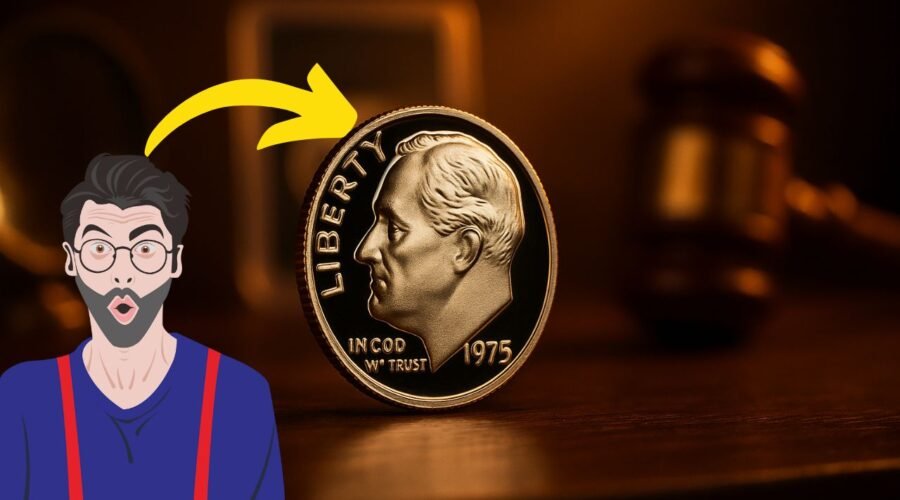1975 “No-S” Roosevelt Dime- Proof-Only Rarity With Huge Potential
The 1975 “No-S” Roosevelt dime is one of the rarest modern U.S. coins. In 1975, all proof dimes were made at the San Francisco Mint and should carry an “S” mint mark.
Due to a minting mistake, a tiny number were struck without the “S.”
Today, only two authenticated examples are publicly known, which puts this coin in the “unicorn” category for collectors.
With supply essentially fixed and demand deep among advanced numismatists, prices have steadily climbed.
How The Error Happened
Proof coins are struck with specially prepared dies and are packaged in proof sets.
If a die meant for San Francisco proofs lacked the “S” mint mark, every coin from that die would be missing it. Quality checks usually catch such errors, but a few sets can slip out.
That’s what appears to have happened in 1975, making the “No-S” proof dime a true production anomaly.
Specifications And Quick Facts
| Attribute | Details |
|---|---|
| Denomination | Roosevelt Dime (10 cents) |
| Year | 1975 |
| Mint | San Francisco (Proof-only issue) |
| Error Type | Missing “S” mint mark on a proof coin |
| Known Examples | 2 (publicly confirmed) |
| Composition | Copper-nickel clad (outer layers 75% copper, 25% nickel over pure copper core) |
| Diameter | 17.90 mm |
| Weight | 2.27 g |
| Edge | Reeded |
| Designer | John R. Sinnock |
| Typical Surfaces | Deeply mirrored fields, frosted devices (proof finish) |
| Value Range (Public Sales) | Mid-six figures, with records exceeding $500,000 |
Price History And Market Potential
Over the last decade, public sales have placed the 1975 “No-S” dime firmly in the mid- to high-six-figure bracket.
Notably, certified examples in PR67–PR68 have set headline prices, and the most recent public record pushed beyond $500,000.
Because only two are known, any reappearance can reset expectations.
Add in the steady global demand for top-tier modern rarities, and many specialists view this coin as a trophy asset rather than a typical collectible.
If a third authenticated example ever surfaces, it could spark intense competition and fresh price discovery.
How To Identify A Genuine 1975 “No-S” Proof
- Start With A Proof Set: The known coins came from 1975 proof sets, not pocket change. A random 1975 dime in circulation without a mint mark is usually a Philadelphia circulation strike, not the rare proof error.
- Check The Surfaces: True proofs show mirrored fields and sharp, frosted designs. Circulation coins have a satin look and often show wear.
- Look For The Mint Mark Area: On a normal 1975 proof, an “S” is present. On the “No-S” error, that spot is clean—no letter, no trace. Use a loupe.
- Authenticate And Grade: If your coin looks right, do not clean it. Submit it to a top grading service for authentication and a numeric grade. A single grade point can change value by tens of thousands.
Collecting Tips And Common Pitfalls
- Don’t Confuse Circulation Dimes: Many 1975 dimes without any mint mark are just Philadelphia business strikes—they are common and not related to this proof error.
- Beware Of Alterations: Added or removed mint marks, polished surfaces, or cleaned coins are red flags.
- Provenance Matters: With ultra-rare pieces, pedigree (who owned it before) and a clear certification trail help safeguard value.
- Think Long Term: Ultra-low population and sustained demand support a long-horizon outlook. Most serious buyers consider this a once-in-a-generation opportunity.
The 1975 “No-S” Roosevelt dime is a proof-only mint error with only two public examples, a documented six-figure track record, and recent results over $500,000.
Its appeal rests on a perfect storm of factors: ultra rarity, clear diagnostic features, and the prestige of owning a top modern U.S. trophy coin.
If you think you’ve found one, proceed carefully—proof finish first, no “S” second, and professional authentication third—because the right coin could be life-changing.
FAQs
Can I Find One In Pocket Change?
Highly unlikely. The known pieces surfaced from 1975 proof sets, not from circulation.
What Grades Are Typical For The Known Coins?
They’ve been certified in the PR67–PR68 range—premium proof grades that command headline prices.
What’s The Biggest Mistake New Collectors Make?
Assuming any 1975 no-mintmark dime is rare. Most are Philadelphia circulation strikes; the valuable one is a proof with no “S.”


Leave a Reply